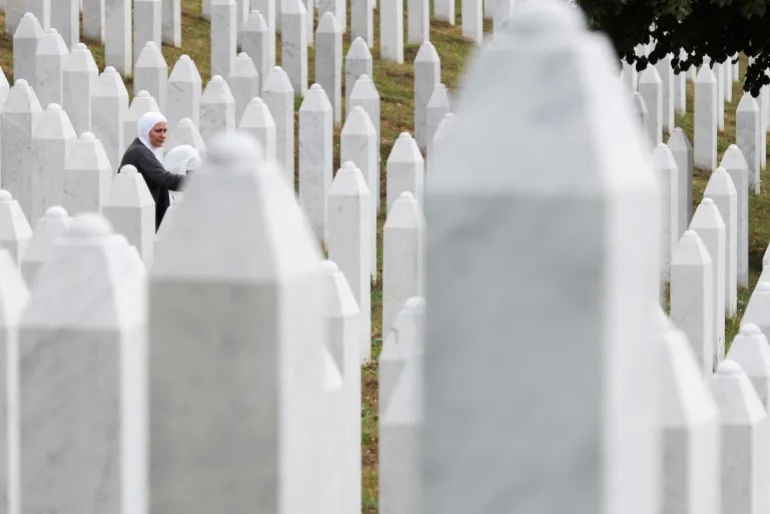Thirty-Year Narrative of the Hell of Srebrenica
TEHRAN (Defapress) - In July 1995, a lush valley in eastern Bosnia, once known for its silver mines, became a scene of horror and sorrow. Srebrenica, a small town near the Drina River, which had been declared a UN safe zone, witnessed one of the darkest chapters in Balkan history. This report tells the stories of Nedžad Avdić, Hajrudin Mešić, and Emir Bektić, 3 survivors who, amid war, the loss of loved ones, and a deadly march through Bosnian forests, left behind a tale of pain, hope, and endurance.

Nedžad Avdić: The Boy Who Loved Geography
Nedžad, a 17-year-old who adored geography, once spoke about the differences between dense and scattered settlements in his village of Sebičina and used moss on trees to find north. But in the summer of 1995, his knowledge of geography became a test of survival. In the Slapoviči displacement camp, where he lived with his family in wooden cabins without electricity or water, the sound of explosions drove him into the dense forests of eastern Bosnia. Amid the chaos, he lost his father and joined thousands of men and boys fleeing toward the safe city of Tuzla.
During the death march, Nedžad faced terror, hunger, and thirst. In the village of Kamenica, he was captured by Serb soldiers and endured humiliation, beatings, and forced chants praising the enemy. In a truck transporting him to his execution, he breathed through a hole in the tarp and watched others drink their own urine out of thirst. Eventually, he was wounded by gunfire and fell among the dead. But with the help of a man who bit through his ropes, he crawled through forests and burned villages toward freedom. When water was poured over his face in Zvornik near Tuzla, he wept, realizing he had survived. Yet the loss of his father, three uncles, three cousins, and his family photos left an eternal wound on his heart.
Hajrudin Mešić: The Surviving Brother
Hajrudin, a 21-year-old, had already lost two brothers in the war, one to a sniper, the other in an attack on a schoolyard in Srebrenica. In July 1995, when bullets struck their family apartment, he fled into the woods with his two remaining brothers, Hasan and Safet, while his elderly parents sought refuge at the UN base in Potočari. During their escape, in the village of Kamenica under heavy fire, Hasan was wounded, and Hajrudin lost both brothers. He pressed on with a small group, slept in mud under the rain, and with blistered, shoeless feet, clung to wild figs to stave off hunger.
Near the village of Brežik, he and a friend named Hasan were caught in gunfire again. In a deserted trench, he watched as two men and a 16-year-old boy named Musa died, the boy begging for a shoelace to bind his wound. Hajrudin and Hasan ran toward soldiers they initially thought were enemies but turned out to be allies. Bread and safety gave them a second life. Yet Hajrudin had lost four brothers and 24 relatives. His brother Hasan was later killed by a landmine, and Safet remains missing. Today, he teaches history and geography in Sarajevo and takes his students to Srebrenica each year to honor the victims.
Emir Bektić: Alone in a Crowd
Emir, a 16-year-old boy, fled into the woods with his father, Redžep, after he returned bloodied from a nearby village bombing and said, "Srebrenica no longer exists." His mother and sister went to the UN base, and he left wondering if he would ever see them again. During the death march, thirst forced him to drink muddy water. On a hill near Tuzla, he was captured and fell asleep in his father’s arms. When he woke, he was alone, leaning against an oak tree. His father had vanished, perhaps hiding him in the dark to save him.
Emir was captured again, but his uncle forced him to run toward buses transporting women and children from Potočari to Tuzla. He hid under a blanket and reached freedom. But his father, uncle, and two cousins were later found in mass graves in Kamenica. Emir, who now lives in Sarajevo, has written his story in a book titled "Lonely Dawn," believing, "I survived, so I must speak."
The Srebrenica massacre, recognized as genocide in 2004 by the International Criminal Tribunal for the former Yugoslavia (ICTY), was the result of "Operation Krivaja 95," planned by Radovan Karadžić, the self-proclaimed leader of Republika Srpska, and led by General Ratko Mladić. The assault, aimed at seizing the UN-protected zone, began with heavy artillery shelling on July 6, 1995. Bosnian Serb forces, backed by Serbia and numbering around 25,000 well-equipped troops, overran the town and surrounding villages. The outgunned Bosnian defenders, disarmed by the UN two years earlier, and the lightly equipped Dutch peacekeepers could not resist. By July 10, Serb forces entered Srebrenica, separating women and children (forced toward Potočari) from men and boys (marched into forests and mass graves).
This attack, a blatant violation of the UN Security Council’s safe zone designation, was not just a military defeat but a humanitarian catastrophe. Serb soldiers used brutal tactics, relentless shelling, sieges, and mass executions, murdering over 8,000 people and displacing thousands more, with many subjected to sexual violence. The crime, also ruled genocide by the International Court of Justice (ICJ) in 2007, remains a stain on the world’s conscience, with Serbia found responsible for failing to prevent it.
The Srebrenica genocide was not just a human rights violation but an organized attempt to erase a people and their culture. This tragedy underscores the need for global vigilance against ethnic hatred and violence. The stories of Nedžad, Hajrudin, and Emir, who, despite unbearable loss, courageously share their testimonies, are a cry for justice and proof that even in the darkest moments, the human spirit can find light through hope and resilience. The world must never allow such atrocities to happen again.
